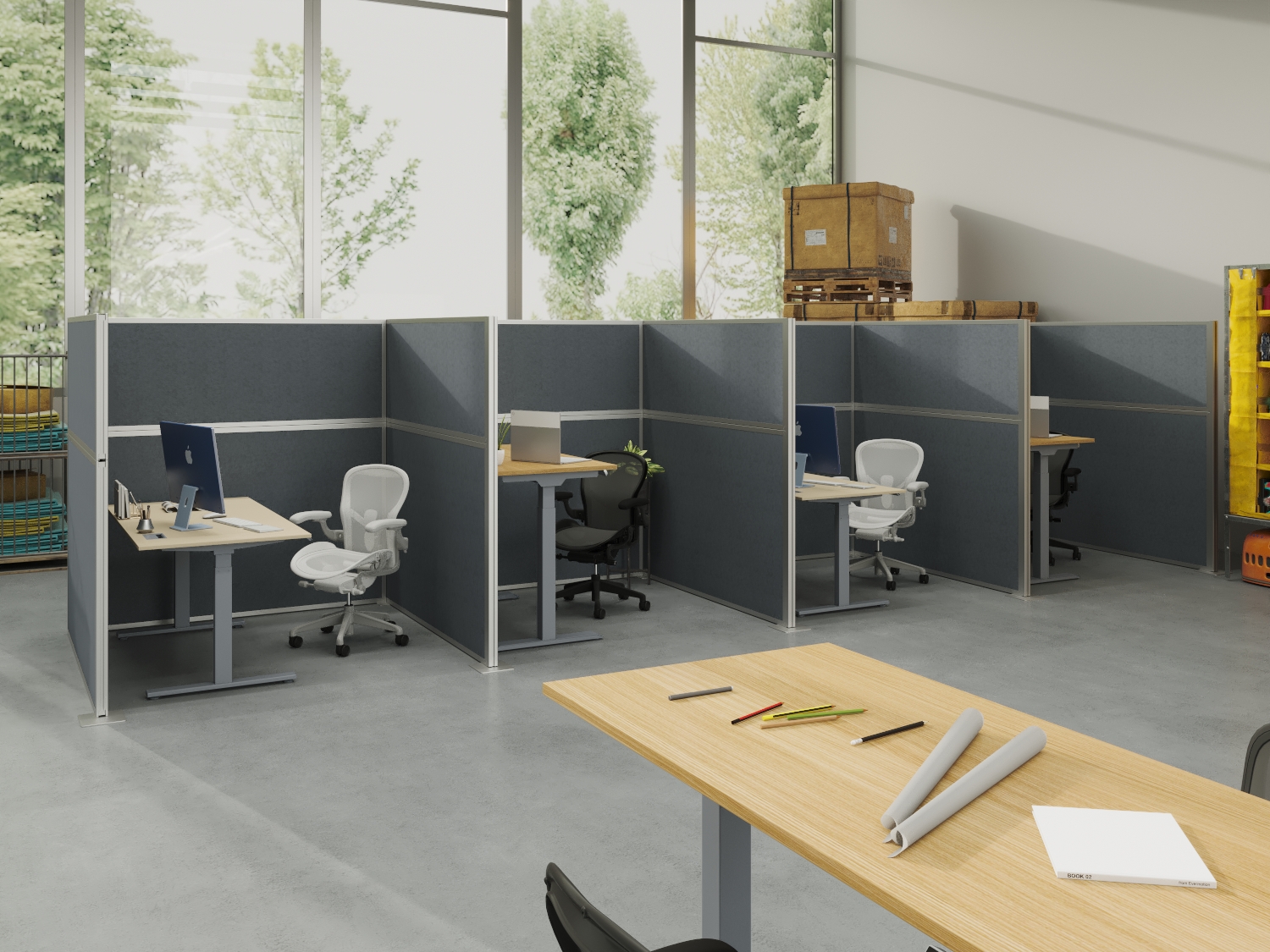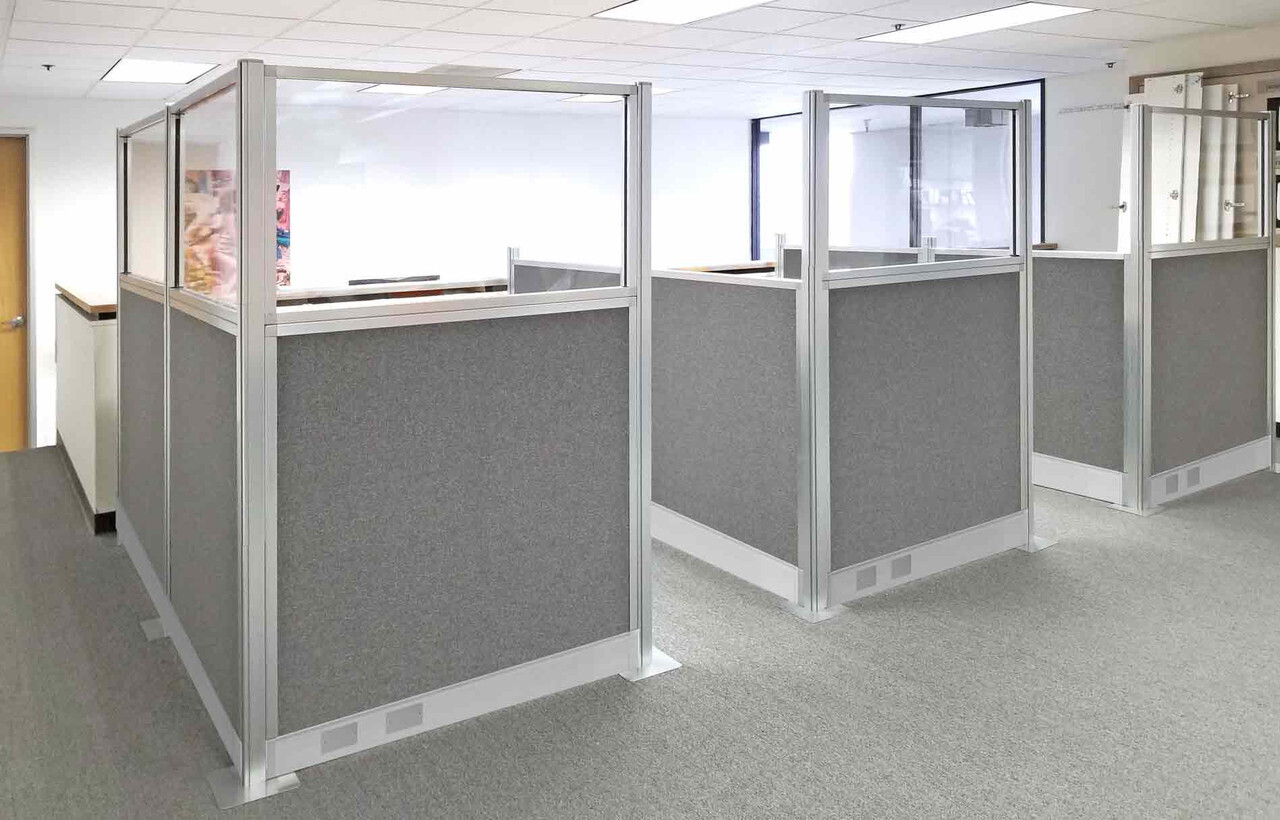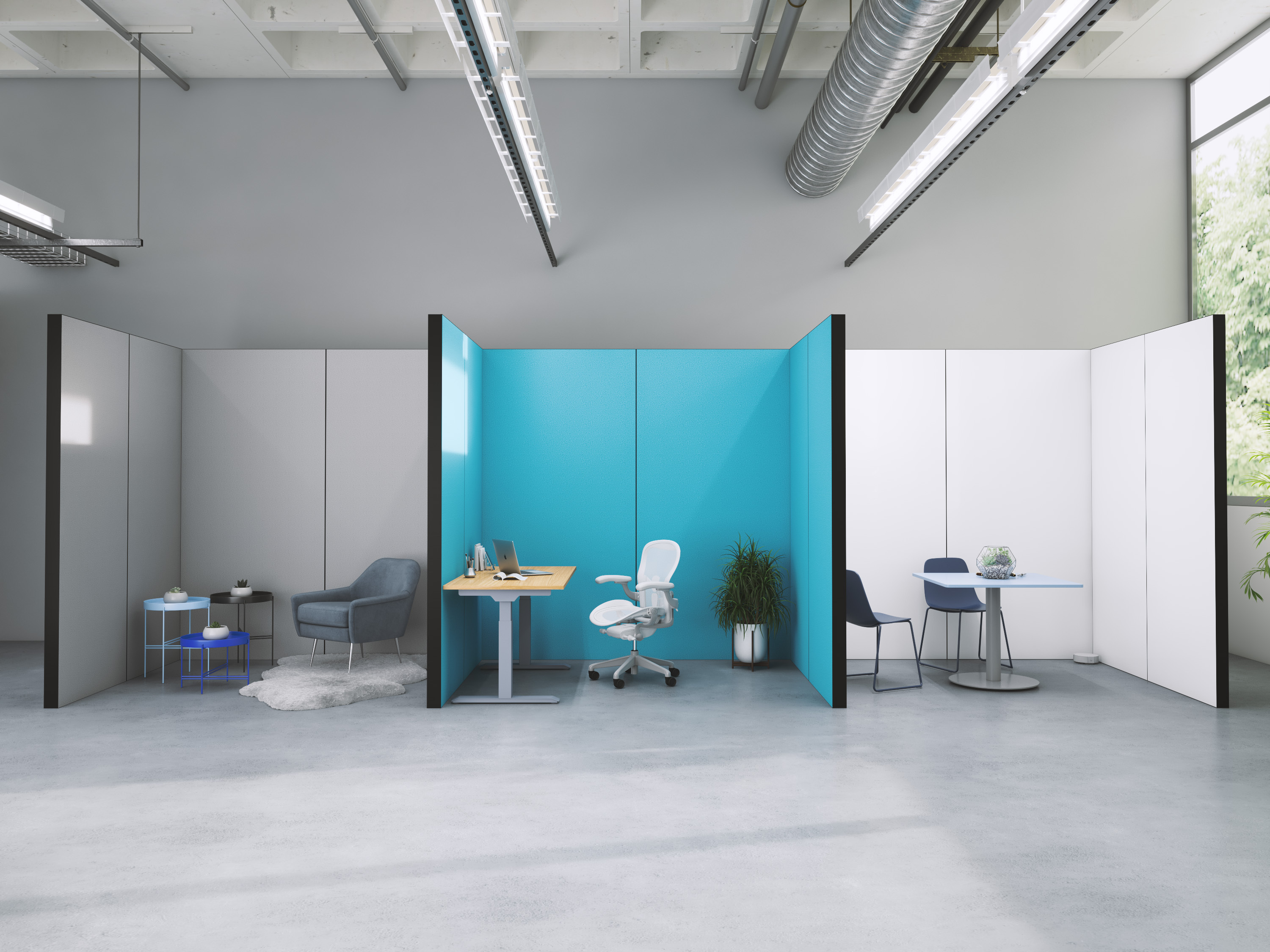The Complete Buying Guide for Cubicles
Posted by Kate Murphy on Mar 4th 2025
When you think of an office, chances are cubicles come to mind. And for good reason—cubicles create structured, organized workspaces that help employees focus, collaborate when needed, and maintain personal space throughout the workday.
But choosing the right office cubicles? That’s where things can get tricky. Size, style, layout, and budget all play a role. The right cubicles can maximize productivity, improve office flow, and even enhance employee satisfaction. Luckily, finding the best fit for your space is easier than your Monday morning coffee run—with the right guidance.
This buying guide covers everything you need to know to choose the perfect office cubicles.
How Much Should a Cubicle Cost?
First things first: The price. Cubicle costs vary widely based on several factors, including size, materials, height, features (such as electric channels, integrated technology, and storage), and installation complexity. A basic cubicle setup might cost a few hundred dollars, while a more elaborate, high-end configuration can run into the thousands.
Consider These Pricing Factors:
-
Size and Configuration: Larger cubicles, or those with unique layouts, cost more.
-
Quantity: Bulk orders often come with discounts.
-
Materials: Higher-quality fabrics, panels, and frames increase durability but also raise costs.
-
Height: Taller cubicles often cost more due to the increased material and labor involved.
-
Customizations: Built-in storage, integrated lighting, ergonomic accessories, glass panels, etc., add to the overall cost.
-
Delivery and Installation: Some vendors include installation, while others charge extra.
No matter your budget, Versare has a cubicle solution for you. Whether you need a single panel starting at just $195 or a larger multi-pack for $2,800+, Versare offers a wide range of budget-friendly options to fit any workspace.

How to Choose Your Style of Cubicle
Cubicles come in different designs to accommodate various work environments. The right style depends on your office layout, employee needs, and the balance between privacy and collaboration.
Common Types of Cubicles:
-
Standard Cubicles: The classic three-sided workspace with optional storage and accessories.
-
Low-Wall Cubicles: Designed for a balance between privacy and teamwork, low-wall cubicles have shorter panel heights, allowing for easy communication between employees while still defining individual workspaces.
-
High-Wall Cubicles: High-wall cubicles feature taller panels that maximize privacy and reduce noise for focused work.
-
Benching Systems: A modern, open-concept alternative to cubicles, benching systems consist of long shared desks that accommodate multiple employees. Dividers can be added for some separation, or they can be left open to encourage collaboration.
-
Call Center Cubicles: These small, space-saving workstations are enclosed on three sides, offering just enough privacy for phone-based roles while fitting tightly into office layouts.
-
Reception Cubicles: Specially designed for front office and receptionist areas, these cubicles are often more open and include counters for visitor interactions.
When Choosing a Cubicle Style, Consider:
-
Employee Roles: What kind of work do your employees do? Do they require privacy for focused work, or do they collaborate frequently?
-
Company Culture: Does your company promote collaboration or individual work?
-
Space Constraints: How much space do you have available? Some cubicle styles are more space-efficient than others.
Selecting the Right Sized Cubicle for Your Space
Next up? Sizes. Office cubicles come in a variety of dimensions, and employers typically select the size based on their budget and the level of privacy they want to provide for employees.
Standard cubicles offer spacious layouts and work surfaces, designed for one employee but roomy enough for an extra chair when needed. The extra space is typically used for computers, file cabinets, and other office equipment. Common cubicle sizes are 6' x 6', 6' x 8', and 8' x 8', with 6' x 6' being the Goldilocks go-to option.
Call center-style cubicles are ideal for high-density environments like call centers, customer service departments, telemarketing offices, and similar businesses that require compact footprints and efficient use of space. Accordingly, the smaller sizes can range from 4' x 2' to 5' x 5' footprints.
Larger cubicles, typically 8' x 8' or bigger, are designed for managerial positions, project leaders, or employees with more complex responsibilities or equipment. These spacious workstations also allow room for collaboration, small meetings, or integrated benching systems.
Quick Cubicle Sizing Tips:
-
In choosing the right size, measure available office space and account for walkways and common areas.
-
Consider employee comfort, as various research suggests that poorly designed spaces can lead to increased stress, lower job satisfaction, and decreased performance.
-
Consider future growth. Modular cubicles offer flexibility, allowing you to easily reconfigure or add to your workspace as your business grows. This adaptability saves time and money, ensuring your office can evolve without major disruptions

Choose the Right Height of Cubicle
Cubicle height impacts both privacy and collaboration. Keep these factors in mind when selecting the right height:
-
Short (42"-47"): Low-walled cubicles offer minimal privacy but allow for easy communication and a more open feel. These are ideal for environments that prioritize communication, teamwork, and visibility.
-
Medium or Standard (48"-66"): Mid-height cubicles provide a balance between privacy and openness. They offer more seclusion than low-height cubicles while still allowing for interaction over the top of the panels. Versare Hush Panel™ Cubicles come in two heights: 4' and 6' (plus an option of 6' with window).
-
Tall (67" or more): High-walled cubicles create a private workspace similar to a mini office. These are best for roles that require concentration. The taller panels minimize visual distractions and help absorb more sound.
What’s the Best Material of Cubicles?
Just like cubicles come in different sizes, they also come in a variety of materials. If you’re going for a specific office vibe, choose a material that matches your style. Need a budget-friendly option? Pick one that delivers the best value while still getting the job done. The choice is yours—it’s all about balancing form, function, and a little fun!
-
Fabric-Covered Panels: Using sound-absorbing fabric in cubicles creates a cozy and comfortable setting. It’s often available in a variety of colors, and the tackability of the panels makes it easy to pin or post pictures, a calendar, or other materials onto the surface for personalization.
-
Laminate: Laminate panels are easy to maintain, clean, and are long-lasting, but they don’t offer the same sound absorption as fabric panels.
-
Acrylic or Transparent Material: Using acrylic or other transparent materials for cubicle walls creates an airy, modern feeling. Yet, their transparency doesn’t provide much visual privacy between employees.
-
Metal: Often used in high-traffic areas like factories, warehouses, and industrial offices, metal cubicle walls are sturdy and can withstand heavy-duty wear and tear.
For a balance of sound control, aesthetics, and practicality, fabric-covered panels are a top choice for most offices.
Best Practices for Installing Cubicles
The installation charge for cubicle setup varies based on several factors, including:
-
Number of Cubicles: Larger installations typically have lower per-unit costs.
-
Cubicle Size and Complexity: Larger or more complex cubicles take more time to install.
-
Location: Labor costs vary by region.
-
Additional Services: Disassembly of old cubicles, electrical wiring, or custom modifications may add to the cost.
On average, professional installation can range from a couple hundred to $1,000 per cubicle, with simpler setups on the lower end and more complex configurations (e.g., high-walled or powered cubicles) on the higher end. Some companies charge a flat rate for small installations, while larger projects may be priced per cubicle or by the hour.

Why Choose Versare Cubicles?
Versare makes setup easy with:
-
Toolless Assembly: With Versare’s innovative toolless design, setting up your cubicles is a breeze. You won’t need professional installers or special tools to assemble the workstations. Versare’s easy-to-follow, step-by-step instructions ensure you can assemble, adjust, and configure each cubicle with minimal effort, saving time and money.
-
Modular Design: Hush Panel™ Cubicles feature a versatile, modular design that makes it easy to adapt to your evolving office needs. As your team grows or your layout changes, simply reconfigure your cubicles to create the perfect workspace
-
Budget-Friendly Choices: Versare is committed to providing affordable, high-quality office solutions. Cubicles from Versare offer excellent value for businesses of all sizes, whether you're outfitting a small startup or expanding a larger enterprise. By eliminating the need for professional installation and offering a durable, long-lasting product, Versare helps businesses make the most of their budgets without compromising on quality or style.
Explore Versare Cubicles Today
Ready to transform your office? Versare has you covered with Hush Panel™ Cubicles, offering top-notch quality that fits your budget and your style! And whether you’re looking for preconfigured cubicle kits, custom designs, or sleek desktop dividers, Versare has got something for everyone and every business.
To find the perfect fit for your workspace, contact Versare’s friendly sales experts to talk through your office setup, budget, and needs, and get a personalized quote.


